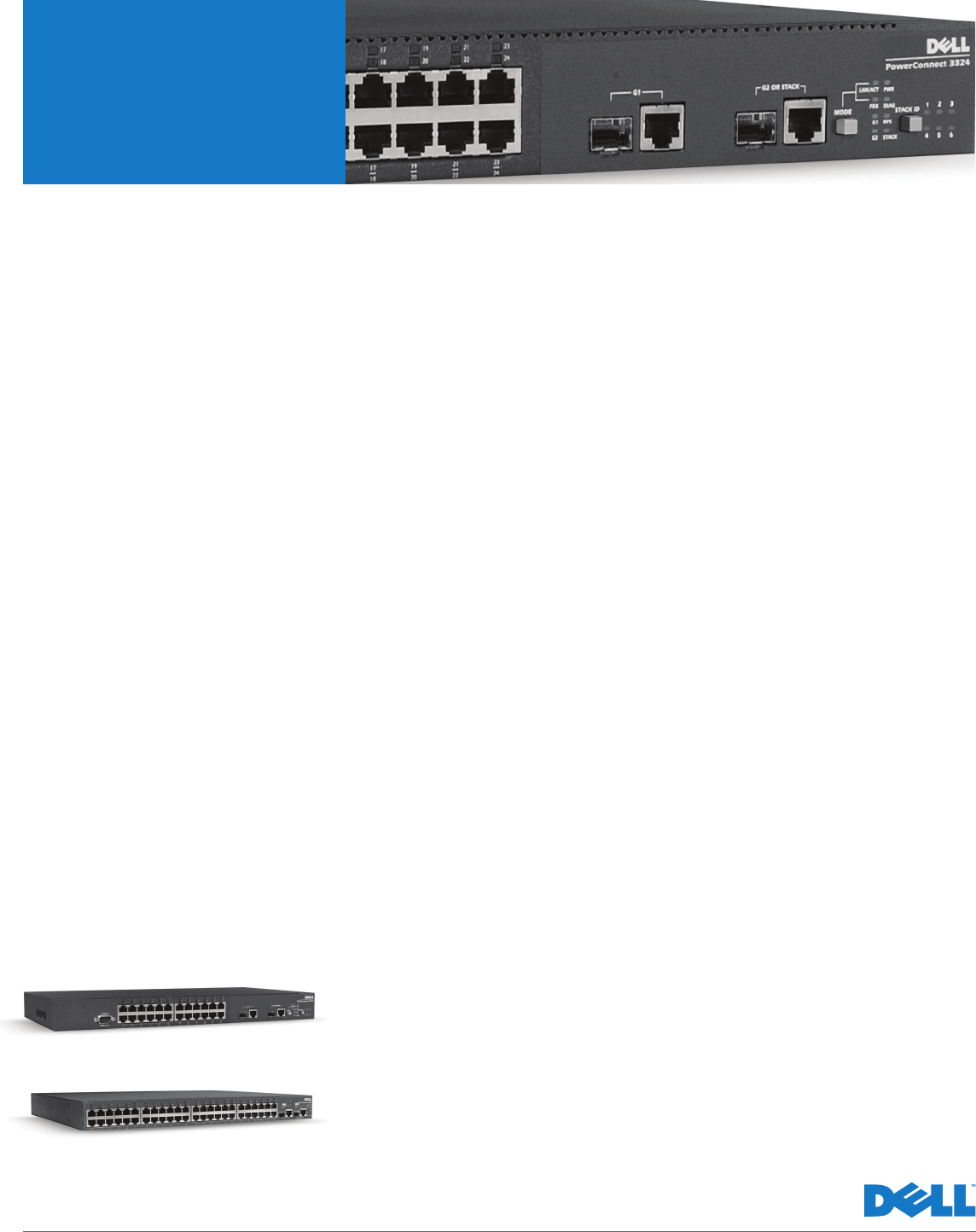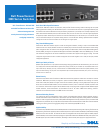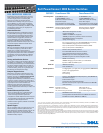
Dell PowerConnect
3300 Series Switches
Dell
™
PowerConnect
™
3324 and 3348
stackable Fast Ethernet switches offer
advanced management and
security features for high-performance
workgroup connectivity.
Rack-Dense Wire-Speed Performance
PowerConnect 3300 Series switches are rack-dense, fixed-port Fast Ethernet switching solutions delivering full wire-speed
switching performance. Offering 24 or 48 Fast Ethernet ports in a 1U form factor with two built-in copper Gigabit Ethernet ports,
the PowerConnect 3324 and 3348 switches have total switching capacities of up to 8.8 Gbps and 13.6 Gbps respectively. Each
switch offers additional flexibility with its two SFP transceiver slots, which can be used in lieu of the two copper Gigabit ports
to support fiber media. Additionally, the PowerConnect 3324 and 3348 switches can be stacked up to six switches with as
many as 192 Fast Ethernet ports via an optional stacking module in one of the SFP slots. Stacking capabilities deliver simplified
management as the entire stack of switches can be managed as a single system.
Easy, Powerful Management
PowerConnect 3300 Series switches support a number of management interfaces, including an easy-to-use embedded Web
interface as well as an industry-standard Command Line Interface (CLI), which allows network administrators to utilize existing
switch configuration skills. The switches can be managed remotely via a Web browser, Telnet or Simple Network Management
Protocol (SNMP), and support a comprehensive Management Information Base (MIB) as well as four RMON groups. To assist
with centralized management of the network infrastructure, the switches also support remote logging via syslog. This broad
management support eases the tasks of network management and ensures integration into a variety of third party network
management applications.
Multi-Layer Quality of Service
Network traffic prioritization is a key requirement for deploying emerging applications like videoconferencing and voice-over-IP.
The PowerConnect 3324 and 3348 switches provide four priority queues per port. Packets can be classified based on the
Layer 2 IEEE 802.1p standard, the Layer 3 IP Precedence or IP Differentiated Services Code Point (DSCP) standard, or the
Layer 4 standard utilizing TCP/IP ports. These capabilities help increase deployment flexibility and protect networking
infrastructure investments.
Robust Security
Advanced security features of the PowerConnect 3300 Series switches help protect the network from accidental or malicious
interference. MAC-based port security is designed to prevent unauthorized MAC addresses from accessing the network.
Access Control Lists (ACLs) deliver even tighter control over the network by allowing or denying traffic flows based upon the
flow’s source or destination MAC address, source or destination IP address, source or destination TCP/UDP port, DSCP value
or IP Precedence. SSL and SSH encryption offer the added security of encrypting switch management traffic. RADIUS support
enables centralized, remote authentication of administrative access to the switch. SNMP access filtering provides a
mechanism to limit network hosts that have SNMP access to the switches.
Advanced Switching Features
The PowerConnect 3324 and 3348 switches support a variety of standards-based advanced switching features, allowing a
network administrator to optimize traffic flow in the network. Up to 247 VLANs are supported, enabling limitation of broadcast
domains as well as improved network security. GVRP (GARP VLAN Registration Protocol) provides for dynamic port-based VLAN
configuration as per IEEE 802.1Q, and helps reduce administrative tasks associated with static VLANs. Other advanced features
including port mirroring, dynamic link aggregation (LACP), and IP multicast support (IGMP v1 and v2).
High Availability
The PowerConnect 3300 Series offers several availability features to meet enterprise networking needs. Spanning Tree Protocol and
Rapid Spanning Tree Protocol support help reduce network setup time and improve network availability by automatically activating
standby links if the active link fails. The switches also store dual configuration files and firmware images for rollback purposes.
Overall availability can be further increased by deploying the optional Dell PowerConnect RPS-600 redundant power system. Each
RPS-600 supports up to four PowerConnect switches, eliminating a switch’s internal power supply as a single point of failure.
Visit www.dell.com/networking for more information.
Simplicity and Performance. Easy as
PowerConnect 3348
PowerConnect 3324




